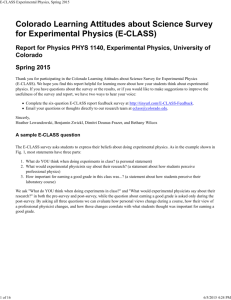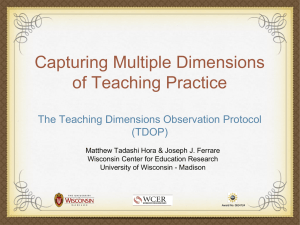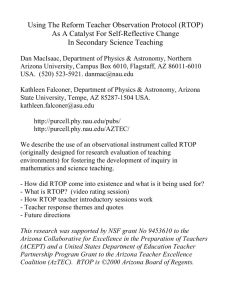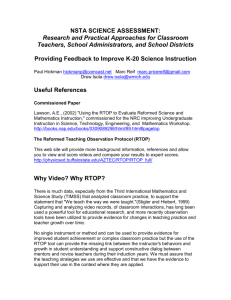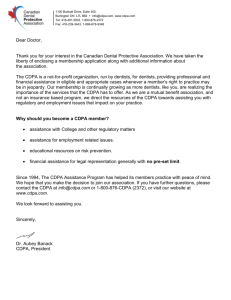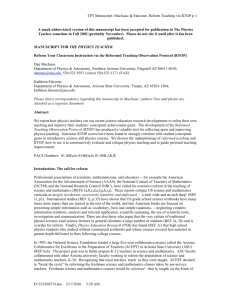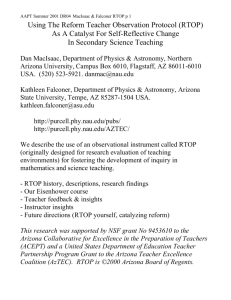PowerPoint - Kansas State University
advertisement
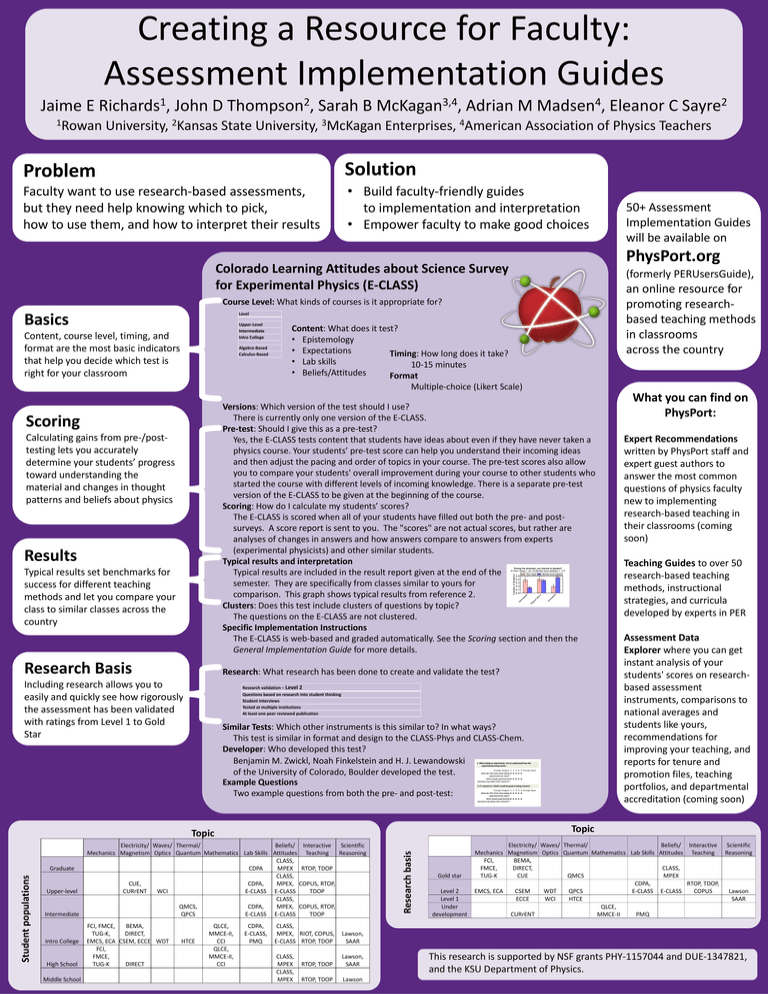
Creating a Resource for Faculty: Assessment Implementation Guides Jaime E 1 Richards , 1Rowan University, John D 2Kansas 2 Thompson , Sarah B State University, 3,4 McKagan , 3McKagan Enterprises, Adrian M 4American 4 Madsen , Association of Physics Teachers Problem Solution Faculty want to use research-based assessments, but they need help knowing which to pick, how to use them, and how to interpret their results • Build faculty-friendly guides to implementation and interpretation • Empower faculty to make good choices (formerly PERUsersGuide), an online resource for promoting researchbased teaching methods in classrooms across the country Course Level: What kinds of courses is it appropriate for? Level Upper-Level Intermediate Intro College Content, course level, timing, and format are the most basic indicators that help you decide which test is right for your classroom Algebra-Based Calculus-Based Content: What does it test? • Epistemology • Expectations Timing: How long does it take? • Lab skills 10-15 minutes • Beliefs/Attitudes Format Multiple-choice (Likert Scale) Versions: Which version of the test should I use? There is currently only one version of the E-CLASS. Pre-test: Should I give this as a pre-test? Yes, the E-CLASS tests content that students have ideas about even if they have never taken a physics course. Your students’ pre-test score can help you understand their incoming ideas and then adjust the pacing and order of topics in your course. The pre-test scores also allow you to compare your students' overall improvement during your course to other students who started the course with different levels of incoming knowledge. There is a separate pre-test version of the E-CLASS to be given at the beginning of the course. Scoring: How do I calculate my students’ scores? The E-CLASS is scored when all of your students have filled out both the pre- and postsurveys. A score report is sent to you. The "scores" are not actual scores, but rather are analyses of changes in answers and how answers compare to answers from experts (experimental physicists) and other similar students. Typical results and interpretation Typical results are included in the result report given at the end of the semester. They are specifically from classes similar to yours for comparison. This graph shows typical results from reference 2. Clusters: Does this test include clusters of questions by topic? The questions on the E-CLASS are not clustered. Specific Implementation Instructions The E-CLASS is web-based and graded automatically. See the Scoring section and then the General Implementation Guide for more details. Scoring Calculating gains from pre-/posttesting lets you accurately determine your students’ progress toward understanding the material and changes in thought patterns and beliefs about physics Results Typical results set benchmarks for success for different teaching methods and let you compare your class to similar classes across the country Research Basis Research: What research has been done to create and validate the test? Including research allows you to easily and quickly see how rigorously the assessment has been validated with ratings from Level 1 to Gold Star Research validation – Level 2 Questions based on research into student thinking Student interviews Tested at multiple institutions At least one peer reviewed publication Similar Tests: Which other instruments is this similar to? In what ways? This test is similar in format and design to the CLASS-Phys and CLASS-Chem. Developer: Who developed this test? Benjamin M. Zwickl, Noah Finkelstein and H. J. Lewandowski of the University of Colorado, Boulder developed the test. Example Questions Two example questions from both the pre- and post-test: Intermediate Intro College High School Middle School Electricity/ Waves/ Thermal/ Beliefs/ Interactive Scientific Mechanics Magnetism Optics Quantum Mathematics Lab Skills Attitudes Teaching Reasoning CLASS, CDPA MPEX RTOP, TDOP CLASS, CUE, CDPA, MPEX, COPUS, RTOP, CURrENT WCI E-CLASS E-CLASS TDOP CLASS, QMCS, CDPA, MPEX, COPUS, RTOP, QPCS E-CLASS E-CLASS TDOP FCI, FMCE, BEMA, TUG-K, DIRECT, EMCS, ECA CSEM, ECCE WDT FCI, FMCE, TUG-K DIRECT HTCE QLCE, MMCE-II, CCI QLCE, MMCE-II, CCI CDPA, E-CLASS, PMQ CLASS, MPEX, RIOT, COPUS, E-CLASS RTOP, TDOP CLASS, MPEX CLASS, MPEX Research basis Student populations Upper-level What you can find on PhysPort: Expert Recommendations written by PhysPort staff and expert guest authors to answer the most common questions of physics faculty new to implementing research-based teaching in their classrooms (coming soon) Teaching Guides to over 50 research-based teaching methods, instructional strategies, and curricula developed by experts in PER Assessment Data Explorer where you can get instant analysis of your students' scores on researchbased assessment instruments, comparisons to national averages and students like yours, recommendations for improving your teaching, and reports for tenure and promotion files, teaching portfolios, and departmental accreditation (coming soon) Topic Topic Graduate 50+ Assessment Implementation Guides will be available on PhysPort.org Colorado Learning Attitudes about Science Survey for Experimental Physics (E-CLASS) Basics Eleanor C 2 Sayre Gold star Level 2 Level 1 Under development Electricity/ Waves/ Thermal/ Beliefs/ Interactive Scientific Mechanics Magnetism Optics Quantum Mathematics Lab Skills Attitudes Teaching Reasoning FCI, BEMA, FMCE, DIRECT, CLASS, TUG-K CUE QMCS MPEX CDPA, RTOP, TDOP, EMCS, ECA CSEM WDT QPCS E-CLASS E-CLASS COPUS Lawson ECCE WCI HTCE SAAR QLCE, CURrENT MMCE-II PMQ Lawson, SAAR RTOP, TDOP Lawson, SAAR RTOP, TDOP Lawson This research is supported by NSF grants PHY-1157044 and DUE-1347821, and the KSU Department of Physics.
